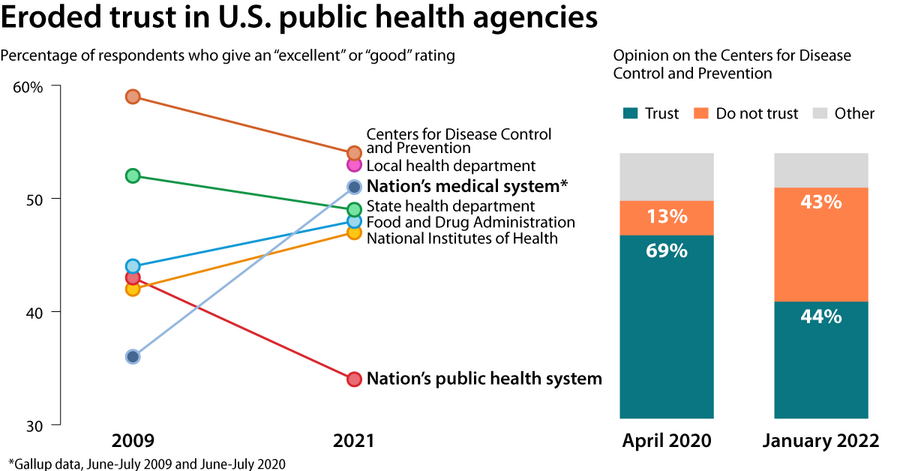Health agencies have lost public trust: Can that be fixed?
Loading...
The pandemic has revealed what experts say are deep shortcomings in America’s public health system. Guidance from the Centers for Disease Control and Prevention on topics from masking to isolation has been consistently confusing. Even now, sought-after COVID-19 test kits and public health data either arrive late or don’t arrive at all. Some local public health departments still send data through snail mail or fax machines.
Implementing fixes will be difficult, but the agencies and Congress are increasingly motivated to start. Core to the challenge: America’s public health system is sprawling, hard to coordinate, and recovering from decades of underinvestment. But many experts say better communication with the public is an important, and feasible, place to start.
Why We Wrote This
As the pandemic enters its most hopeful phase in months, its handling by public health officials is still scored poorly by Americans. Lessons for the government abound, from messaging to longer-term planning.
On Wednesday, the Biden administration released a new 96-page pandemic plan tailored to a return to more normal life. In a briefing with reporters, White House and public health officials announced increased access to treatments and vaccines, updated systems to monitor the virus, and closer coordination with state and local partners.
The document itself starts more simply. Goal No. 1, it says, is: “Restore trust with the American people.”
Falling COVID-19 cases and hospitalizations are pushing America toward the most hopeful phase of this pandemic in months. But America’s public health agencies – responsible for keeping those numbers low – may be at their weakest point in years.
In January, the Government Accountability Office added the Department of Health and Human Services to its High Risk List for “federal programs and operations that are vulnerable to fraud, waste, abuse, and mismanagement, or need transformation.”
And trust in agencies that HHS oversees – the Centers for Disease Control and Prevention (CDC) and the Food and Drug Administration (FDA) – has plummeted, based on polling now versus the dawn of the pandemic in 2020.
Why We Wrote This
As the pandemic enters its most hopeful phase in months, its handling by public health officials is still scored poorly by Americans. Lessons for the government abound, from messaging to longer-term planning.
Americans consistently report low trust in government. With public health, the challenges were magnified early in the pandemic as President Donald Trump disagreed with or undercut agency officials.
But problems have persisted over the past year even under a new president. The trust deficits are in part a performance review – with evidence to back it up.
CDC guidance on topics from masking to isolation has been consistently confusing. The administration and FDA advisory committee publicly disagreed about the need for booster shots last fall, slowing their rollout. Even now, sought-after COVID-19 test kits and public health data either arrive late or don’t arrive at all. Some local public health departments still send data through snail mail or fax machines.
Fixing American public health will be difficult, but the agencies and Congress are increasingly motivated to start. Core to the challenge: America’s public health system is sprawling, hard to coordinate, and recovering from decades of underinvestment. Add in the patchwork interplay of state and local governments, and the system currently is not set up to succeed in a crisis, says Thomas Bollyky, director of the global health program at the Council on Foreign Relations.
“Governments can really only protect their citizens by convincing them to take measures to protect themselves,” Mr. Bollyky says. “Especially in free societies, the success of those efforts depends on trust between citizens and their governments as well as among citizens themselves.”
Some of Mr. Bollyky’s research has found that countries with higher levels of trust in government and other people had lower infection rates. The logic: If people believe their government’s advice is reliable and that other people will follow it, the more likely they are to follow it too.
“A real opportunity”
In fact, as a bipartisan effort in Congress seeks to address some of those structural problems, there are things the CDC, FDA, and other agencies can fix on their own – above all communication. Starting with those, says Tom Frieden, CDC director from 2009 to 2017, is the first step.
“As we enter a new phase here, with better tools than we’ve ever had ... I think we do have a real opportunity to see significant improvements in our response and significant increases in the public’s willingness to listen,” says Dr. Frieden.
On Wednesday, the Biden administration released a new 96-page pandemic plan tailored to a return to more normal life. In a briefing with reporters, White House and public health officials announced increased access to and reserves of masks, treatments, and vaccines; updated systems to monitor the virus; and closer coordination with state and local partners.
The document itself starts more simply. Goal No. 1, it says, is: “Restore trust with the American people.”
But in America, getting people to listen to public health authorities can be particularly difficult, says Robert Blendon, an emeritus professor of health policy and political analysis at the Harvard T.H. Chan School of Public Health.
The public doesn’t tend to trust the government or scientists, has little scientific education, and often approaches the virus politically, he says.
Declining funds
Some of the issues stem from things the department’s agencies can’t control, particularly underinvestment. In the past 20 years, as 9/11 and the Great Recession pushed funds elsewhere, public health funding has withered. The budget for the CDC’s Public Health Emergency Preparedness agreements that aid lower-level health departments, for example, fell from $940 million in 2002 to $675 million in 2020. Since the financial crisis, tens of thousands of public health jobs have disappeared.
While funding has risen by about $55 billion since the pandemic began, it’s almost impossible to rebuild an agency in the middle of a crisis. Existing employees are already doing too much work, often with low morale and subpar tools.
“In an age in which everybody has a cellphone ... the public health system is still using fax machines, still filling out papers with pen and ink, and struggling to send information across the street,” says Georges Benjamin, executive director of the American Public Health Association.
That slows down vital data as reports are logged by hand, often resigning policymakers to imperfect decisions based on imperfect information. Local, private, and federal data don’t always sync, especially because the United States, unlike other countries, doesn’t issue a single identifier for each patient.
But the CDC’s issues aren’t just delayed data or medical uncertainty, many experts say. The agency’s communication has been a near-constant issue, from the government’s initial advice not to wear masks to the opaque CDC guidance on isolation during the omicron wave.
“The irony here is that the CDC literally wrote the book on how to communicate in a health emergency,” says Dr. Frieden, the former CDC director. “Be first. Be right. Be credible. Give people concrete, practical, proven things to do to protect themselves and their family.”
Speaking to the nonscientists
Scientists have a tendency to communicate like they’re speaking to other scientists, says Lisa Lee, a former 14-year CDC employee and executive director of the Presidential Bioethics Commission under the Obama administration. That approach doesn’t work for a public that generally doesn’t understand scientific uncertainty or the information that motivates public health decisions, she says. Americans need government agencies to show their work when they give new guidance.
It also might start with a shift in scenery. In past health emergencies, briefings used to be held at the CDC’s Atlanta headquarters. They’re now based in the White House.
“There is a history in crisis response and pandemics, in particular, of building trust in that response even in low-trust environments,” says Mr. Bollyky. “We just simply didn’t follow that guidance in the context of this pandemic.”
At the FDA, the biggest problem may be the appearance or risk of conflicted interests, says David Gortler, a former senior adviser to the FDA commissioner. Commissioners and high-level staff regularly leave public service for jobs at the drug companies they once regulated.
“The FDA is not a transparent organization,” adds Dr. Gortler, now a fellow at the Ethics and Public Policy Center in Washington. “People hate the FDA because they don’t understand what they do.”
Efforts rising in Congress
What is understood is that America’s public health institutions need reform.
In January in the Senate, Democrat Patty Murray of Washington and Republican Richard Burr of North Carolina introduced the PREVENT Pandemics Act, which among other things would fortify public health supply chains, improve agency coordination and data systems, and create a bipartisan task force to review the nation’s COVID-19 response.
That structural reform is necessary, says Celine Gounder, an infectious disease specialist at New York University and a member of the Biden-Harris COVID-19 transition team. But until it arrives, the CDC and other agencies can use existing tools to improve the pandemic response and trust in it. In 2015, she spent months in West Africa working to contain Ebola, an effort that started poorly too. Small things – like using black body bags rather than white ones – lowered public trust and cooperation. But they didn’t know that until they started studying the local culture and addressing local needs.
“There’s a sort of American exceptionalism, where we think we’re somehow different, better, and more sophisticated,” says Dr. Gounder.
Yet the U.S. has consistently experienced similar problems, with the public approaching the virus with different values. Many Americans have been concerned about the pandemic’s spillover impacts on the economy, mental health, and education. Those people shouldn’t be ignored, says Dr. Gounder. They need messages and messengers that speak to them, and they need a stronger social safety net during crisis. The country has low levels of trust, she says, but that doesn’t mean people reflexively fight public health. Hesitancy isn’t the same as resistance.
“You need to address these other concerns effectively,” says Dr. Gounder. “Otherwise, you are going to have that ... backlash.”











